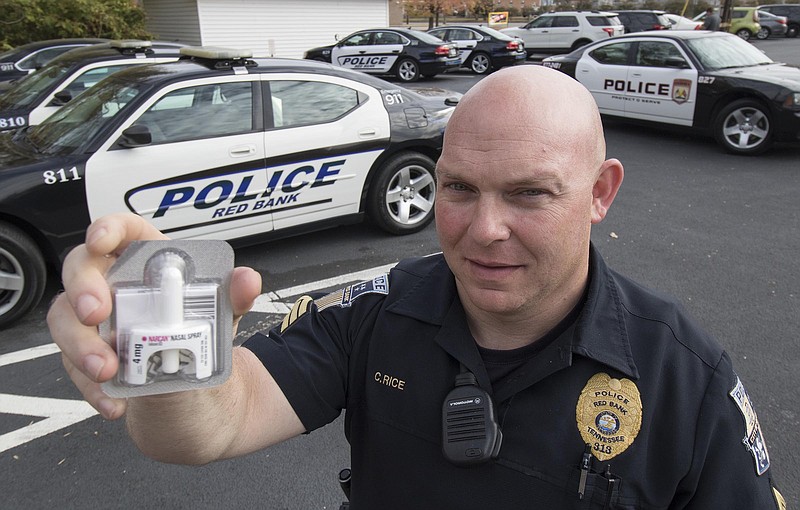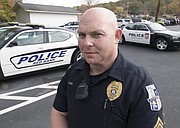HOW IT WORKS
Naloxone blocks the effects of drugs made from opium, or opioids. These include:HeroinMorphineOxycodoneMethadoneFentanylHydrocodoneCodeineHydromorphoneBuprenorphineOpioids slow breathing, so someone who overdoses could stop breathing and die. If given soon enough by shot or nasal spray, naloxone can counter the overdose effects, usually within minutes, according to WebMD.
The man was on the floor of the bathroom, with a syringe between his legs, when Red Bank Police officer Chris Rice saw him.
It was shortly before midnight on a Thursday in late October, and a woman who called 911, crying hysterically that he was overdosing, hovered nearby.
"It was iffy," Rice said last week in an interview at the police department on Dayton Boulevard.
For several months now, Red Bank officers have been equipped with Narcan, a proprietary version of the anti-overdose drug naloxone, but none of them had ever used it outside of training. Rice broke open the small white package and pulled out a nasal injector loaded with the drug, put the tip in the man's nose, and squeezed with his thumb on the injector.
He waited several minutes before a Hamilton County EMS ambulance showed up and took over, trying to get the man to respond. Finally, after five to 10 minutes, the man's eyes opened.
He had overdosed on heroin, he told Rice and the others. He needed to check himself into rehab, he said. And yes, it had happened before.
A paramedic told Rice he saved the man's life.
The news of Rice's rescue was particularly gratifying to Red Bank City Manager Randall Smith and Police Chief Tim Christol, who only months ago had been stung by an overdose tragedy.
Logan Whiteaker was 24 when he graduated from Hamilton County Drug Court in February, apparently free of his decade-long addiction to opiates. His family gathered around him at the celebration, remembering the nightmares they had been through on previous occasions when they had rescued him from an overdose.
But two days later, Whiteaker was dead in his Red Bank home, a hypodermic needle on the floor and suspected heroin on a nearby dresser, according to a police report.
"That was just tragic," Smith said. So he and Christol searched for ways to better respond to the growing overdose problem in this town of about 12,000, which is surrounded by Chattanooga.
"Chattanooga has done such a wonderful job of revitalizing the downtown area, the redevelopment on the North Shore, but as you do those things, you displace a lot of the problems that were keeping it from being revitalized before," Christol said. "A lot is getting pushed to areas like Red Bank and out to East Ridge and Soddy-Daisy and other areas. It's not a negative thing, it's just a reality as we go through and revitalize our communities."
The number of overdoses, arrests and opioid seizures "has increased dramatically over the past few months," he said, blaming easy access to heroin and the powerful painkillers fentanyl and carfentanyl. Fentanyl and carfentanyl are far stronger than heroin and often are mixed with it, with no way for users to know what they are getting.
"There is this whole concept of people not knowing what they're doing and pushing the envelope and stepping over that edge," Christol said.
So Smith and Christol decided to equip all Red Bank police officers with Narcan.
Each kit costs between $40 and $45. Narcan contains naloxone, an opiate that binds to receptors in the brain and blocks other opioids from gaining access. Just as important as the low cost, it has no side affects.
"It was a no-brainer," Smith said. "It will help us save lives, and that is what we are about."
Hamilton County Sheriff's Department officers also carry Narcan in their vehicles, as do Soddy-Daisy police and firefighters, according to EMS Director Ken Wilkerson. Ambulances have been carrying it for many years, but sometimes police officers are first to reach the scene.
"A simple tool like this gives us the opportunity to do something to at least get started and maybe bring that person back to a manageable level until [EMS] can get there and get them to a trauma unit," Christol said.
When police do respond to an overdose, they rarely make an arrest, he said. "We are not charging them unless there is a significant amount of product there," he said. "We need to save this person's life."
Added Smith, "Addiction is an issue they can't control, which is why we have taken the steps we have."
Contact staff writer Steve Johnson at 423-757-6673, sjohnson@timesfreepress.com, on Twitter @stevejohnsonTFP or on Facebook, www.facebook.com/noogahealth.

